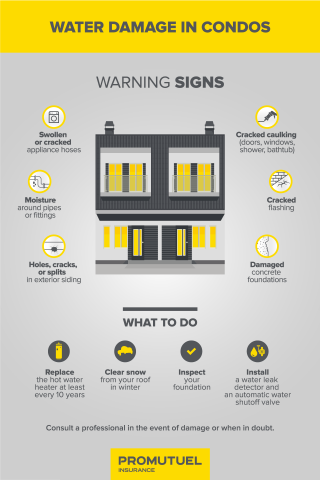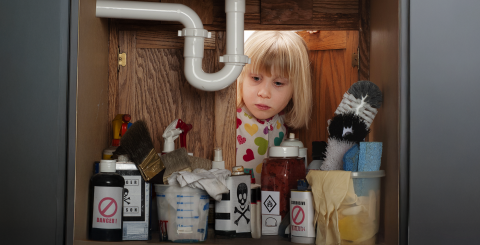How to avoid water damage in a condo

From defective water heaters to problems with pipes and leaks, water damage accounts for the vast majority of claims by syndicates of co-ownership (or condo associations, as they are more commonly known) . Every loss represents a cost to all those involved: compensation for the insurer, deductibles for the insured, more construction waste for the environment, and depreciation of your property’s resale value.
Given all the potential causes of water damage in condos, good risk management and active prevention can save you a lot of hassle in the long run. Here are a few steps condo associations can take to avoid water damage in a condo, as well as some valuable tips.
1. Plumbing
Plumbing-related water damage is common in condos. That’s why the main components of the plumbing system (water main, submersible pumps, backflow prevention devices, exterior taps, etc.) have to be well documented by the syndicate and checked carefully:
- Pipes and fittings under sinks and floors around toilets, washing machines, and water heaters should be dry.
- Pipes and drains should not have any swelling or cracks.
- It is recommended that you replace rubber washing machine and dishwasher hoses every five years and braided steel hoses every ten years.
- Also keep an eye on the shower and bathtub caulking, which should be replaced as needed.
- Repair leaky faucets. Water flowing to the wrong place or a faucet leaking into clogged drain can cause water damage.
- In the fall, purge exterior taps to prevent burst pipes.
- Pay particular attention to submersible pumps (if any) and backwater valves. Check every year to make sure they are working properly.
- Etc.
Contact a master plumber right away if you see any signs of trouble.
It’s crucial for co-owners to know how to find and shut off the water main if needed. In addition, to ensure a quick response in the event of an incident, it is important to make sure a custodian has a copy of the keys to each condo unit.
2. Water heater
An old water heater that gives up the ghost can cause a major spill and a lot of headaches. It’s even worse if it happens in an upstairs unit because the water will also impact the neighbours below! That’s why it’s so important to pay close attention to water heaters:
- They have to be replaced every ten years, or sooner if there are signs of deterioration (oozing, rust, etc.).
- They must be installed according to the manufacturer’s standards.
- Have a drain pan set underneath the water heater, and connect it to a floor drain if there is one.
eaters don’t last forever! Warning: Some insurers no longer insure damage caused by water heaters more than 10 years old.
3. Roofs
Damaged roofing, cracked flashing, ice dams—these are all potential causes of water infiltration, another type of condo water damage that can cause plenty of problems. Vigilance is key:
- Remember that damaged roofing must always be replaced or repaired. Water can also seep through cracks in the flashing.
- Check the attic every spring. Make sure there is sufficient ventilation to avoid problems such as ice dams that can make it easier for snow to build up on the roof.
- Every fall, make sure that gutters and storm drains (for flat roofs) are clear of obstructions.
- Clear snow from the roof periodically in winter. The weight of the snow can cause damage that lets water in during a thaw.
- Don’t try to over-extend the life of your roof. If it’s showing visible signs of wear, plan to have it replaced soon.
- Choose a good roofer. Deciding based on cost alone is not the best way to go. Find out what the estimate includes and get it in writing. Roofers can usually provide you with references for their services. Research them online to see what others are saying about them.
- Etc.
In the event of a problem, the condo association should call a roofing expert.
4. Exterior siding
Exterior siding, doors, and windows protect the building from wind and water. Breaches in the exterior siding can let water in, which is why it’s important to take preventive measures:
- Water has to be able to flow away from the building once it gets to the bottom of the wall. Pitched flashing and weep holes can help.
- Crumbling masonry joints must be repaired.
- Cracked caulking around doors and windows or improperly installed frames can cause water damage in condos.
- Windows less than 4 inches from the ground require a window well.
- Check the condition of your exterior siding for visible holes, cracks, crevices, or movement.
- Etc.
If you see or suspect any damage, see a specialized contractor so they can address the issue quickly.
5. Foundations
It is recommended that you inspect the inside and outside of the foundation (ideally in the spring). Here are some things to look for:
- Moisture causing concrete deterioration at the base of walls and on the floor
- Water infiltration at the base of walls
- Flaking paint at the base of walls and on the floor
- Etc.
To avoid water damage in condos, water must also be effectively drained and channeled away. The syndicate must pay particular attention to the following aspects:
- Surface water – There should be a 10% slope around the foundation perimeter to allow water to drain away.
- Gutter – Gutter downspouts should have a horizontal section at least six feet (1.8 m) long to channel water as far away from the foundation as possible.
- Floor drain – All basements must be fitted with floor drain to allow any water to drain away. The drain must be fitted with a flap to provide additional backup protection.
- Catch basin and pump – If your building has a poor drainage system or the water table is above the foundation drain, it is recommended to install a catch basin and sump pump. Since power failures can occur during wind and rain storms, a backup system should be installed on the pump and inspected periodically.
If you suspect that water is getting in through the foundations, contact a specialist in the field to repair cracks, replace the foundation drain, or fix drainage and other problems.
6. Water detector and automatic water shut-off system
Water leak detectors and automatic water shut-off systems have come on the market in recent years. These systems can be installed by a professional on new or existing plumbing. When a water leak is detected, the detector sends a signal to the system, which automatically cuts the water supply. This reduces the quantity of water that leaks, helping keep damage to a minimum. In addition it can help detect leaks you otherwise might not have noticed. You can find more information on this topic on the PREVDEQ website.
Image


And don’t forget insurance!
Of course, you also need to insure your condo. Keep in mind that there are two types of condo policy: co-ownership insurance taken out by each condo owner and insurance taken out by the syndicate of co-ownership. For more information on the differences between these types of contracts, contact a damage insurance representative. It’s also good to know what’s covered for condo water damage under your basic insurance contract and what requires additional coverage or endorsements.
By checking these key areas, from the roof down to the foundations, and being proactive when issues arise, you’ll greatly reduce the odds of water damage in your condo. And feel free to ask us for a quote for co-ownership insurance or syndicate of co-ownership insurance. We are THERE to insure your home and provide peace of mind—and our prevention advisors are always happy to put their expertise to work for our insured members.




